Related Research Articles

The Schweizer Aircraft Corporation was an American manufacturer of sailplanes, agricultural aircraft and helicopters located in Horseheads, New York. It was incorporated in 1939 by three Schweizer brothers, who built their first glider, the SGP 1-1, in 1930. Previously the oldest privately owned aircraft company in the United States, Schweizer was acquired by Sikorsky Aircraft Corporation of Stratford, Connecticut in 2004, and became a diversified aerospace company. Schweizer Aircraft ceased operations in 2012. It was sold to Schweizer R.S.G. in 2018 and production lines were opened again in Fort Worth, Texas. The company was producing three helicopter models in 2021.

Military gliders have been used by the militaries of various countries for carrying troops and heavy equipment to a combat zone, mainly during the Second World War. These engineless aircraft were towed into the air and most of the way to their target by military transport planes, e.g., C-47 Skytrain or Dakota, or bombers relegated to secondary activities, e.g., Short Stirling. Most military gliders do not soar, although there were attempts to build military sailplanes as well, such as the DFS 228.

The Cessna Airmaster, is a family of single-engined aircraft manufactured by the Cessna Aircraft Company. The Airmaster played an important role in the revitalization of Cessna in the 1930s after the crash of the aviation industry during the Great Depression.

The Schweizer SGS 2-33 is an American two-seat, high-wing, strut-braced, training glider that was built by Schweizer Aircraft of Elmira, New York.
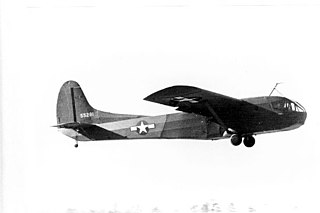
The Waco CG-15 was an American military glider, which was developed from the CG-4. Although outwardly similar to its predecessor and carrying the same number of passengers, a number of changes in the design, including shortened wings and a more streamlined nose enabled it to travel faster. 1,000 were ordered and 473 were delivered before production ceased. Two were transferred to the Navy for testing as the XLR2W-1. One unit was converted into an XPG-3 powered glider which used two Jacobs R-755-9 radial engines.
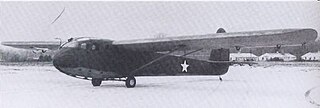
The Waco CG-3A was a US light troop military glider of World War II.

The Waco CG-4 was the most widely used American troop/cargo military glider of World War II. It was designated the CG-4A by the United States Army Air Forces, and given the service name Hadrian by the British.

The Schweizer SGS 1-26 is a United States One-Design, single-seat, mid-wing glider built by Schweizer Aircraft of Elmira, New York.

The Douglas XCG-17 was an American assault glider, developed by the conversion of a C-47 Skytrain twin-engine transport during World War II. Although the XCG-17 was successfully tested, the requirement for such a large glider had passed, and no further examples of the type were built; one additional C-47, however, was converted in the field to glider configuration briefly during 1946 for evaluation, but was quickly reconverted to powered configuration.

The Waco CG-13 was an American military transport glider aircraft developed during World War II.

The Schneider Grunau Baby was a single-seat sailplane first built in Germany in 1931, with some 6,000 examples constructed in some 20 countries. It was relatively easy to build from plans, it flew well, and the aircraft was strong enough to handle mild aerobatics and the occasional hard landing. When the Baby first appeared, it was accepted wisdom that the pilot should feel as much unimpeded airflow as possible, to better sense rising and falling currents of air and temperature changes etc.
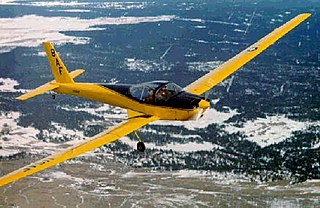
The Schweizer SGM 2-37 is a two-place, side-by-side, fixed gear, low wing motor glider.

The Schweizer SGS 2-8 is an American two-seat, mid-wing, strut-braced, training glider built by Schweizer Aircraft of Elmira, New York.
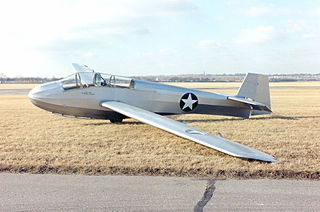
The Schweizer SGS 2-12 is a United States two-seat, low-wing, training glider built by Schweizer Aircraft of Elmira, New York.
The Schweizer SGU 1-19 and Schweizer SGU 1-20 are a family of United States single-seat, high-wing, strut-braced, utility gliders built by Schweizer Aircraft of Elmira, New York.
The Schweizer SGS 1-21 is a United States single-seat, mid-wing, Open Class glider built by Schweizer Aircraft of Elmira, New York.
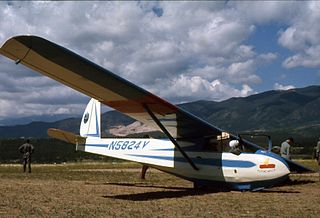
The Schweizer SGU 2-22 is an American two-seat, high-wing, strut-braced, training glider built by Schweizer Aircraft of Elmira, New York.

The Schweizer SGS 1-34 is a United States Standard Class, single-seat, high-wing glider built by Schweizer Aircraft of Elmira, New York.

The Laister-Kauffmann TG-4 was a sailplane produced in the United States during the Second World War for training cargo glider pilots. It was a conventional sailplane design with a fuselage of steel tube construction and wooden wings and tail, covered all over with fabric. The pilot and instructor sat in tandem under a long canopy.
The St. Louis CG-5 was a 1940s American prototype military transport glider designed and built by the St. Louis Aircraft Corporation.
References
- 1 2 3 4 5 6 7 8 9 10 11 12 13 Schweizer, Paul A: Wings Like Eagles, The Story of Soaring in the United States, pages 82-87. Smithsonian Institution Press, 1988. ISBN 0-87474-828-3
- 1 2 3 4 5 6 Smithsonian Institution (2004). "Directory of Airplanes" . Retrieved 2008-05-13.
- 1 2 Schweizer, Paul A: Wings Like Eagles, The Story of Soaring in the United States, pages 78. Smithsonian Institution Press, 1988. ISBN 0-87474-828-3